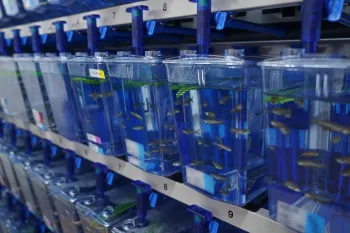Brussels — Nearly 400,000 fish have been used in chemical safety tests required by the EU’s REACH regulation—with a further 530,000 to 690,000 projected to suffer following recent regulatory changes—according to a new analysis commissioned by Humane World for Animals (formerly called Humane Society International) and published in the peer-reviewed journal ALTEX.
The study is the first to quantify the full toll of REACH testing on aquatic animals, revealing the significant and growing impact of current information requirements on fish populations—particularly zebrafish, highly social and cognitively complex animals now widely used in toxicity studies.
As a primary chemical safety regulation for EU Member States, REACH (Registration, Evaluation, Authorisation and Restriction of Chemicals) permits animal testing only as a last resort in cases where no alternative methods are available. Unfortunately, evidence suggests that millions of animals are still used in chemical safety tests under REACH, with numbers projected to rise further in coming years.
“The scale of testing revealed in our analysis raises fundamental questions about whether REACH is delivering protection in the most effective and proportionate way,” said Antigoni Effraimidou, senior program director for institutional policy at Humane World for Animals Europe. “Chemical safety must remain paramount—but we can and must achieve it through modern non-animal methods that strengthen health and environmental protection outcomes.”
The findings come at a pivotal moment as the European Commission revises its proposal for REACH reform. Humane World for Animals is calling for the EU to:
- revise REACH information requirements to replace fish acute toxicity, fish bioconcentration and other obsolete animal tests with state-of-the-art non-animal methods;
- deploy resources more efficiently to better protect human health and the environment;
- establish a scientific committee within the European Chemicals Agency (ECHA) for the use of non-animal methods;
- remove(and not add) obsolete tests, and
- Improve chemical safety by enforcing its guidance on animal testing as “a last resort.”
“These findings show that Europe’s chemical safety system remains rooted in outdated animal models, even as better scientific tools are available,” said Jay Ingram, managing director for chemicals at Humane World for Animals. “Modernising REACH is not about lowering standards—it’s about raising them, by using advanced approaches that better protect people, ecosystems and animals alike.”
The new analysis builds on earlier research showing that over 4.2 million mammals have already been used in REACH systemic toxicity studies, underscoring the shocking scale of animal use required under the current EU chemicals regime.
Humane World for Animals works with EU policymakers, scientific experts, industry leaders, and civil-society partners to accelerate the transition toward an animal-free safety assessment system that delivers smarter science, safer chemicals, and stronger protection for all.
Notes to editors
- Study: Fish count, too – The animal toll of REACH aquatic toxicity tests (ALTEX, 2025)
- Fish are used across four major REACH test categories: short-term toxicity, long-term toxicity, endocrine disruption, and bioaccumulation tests.
- Current evidence indicates fish are similar to mammals in their ability to feel pain.
- Projected additional use of 530,000–690,000 fish represents a substantial increase in animal use for chemical safety assessments.
- Related study on noncompliance with REACH last resort requirement: The last resort requirement under REACH: From principle to practice (Regul Toxicol Pharmacol, 2024)
#
